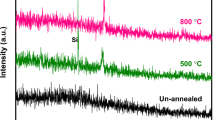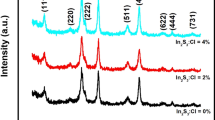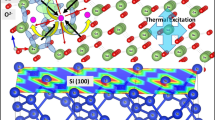Abstract
Silver selenide (Ag2Se) thin films of thickness between 80 and 160 nm were prepared by thermal evaporation method. From XRD studies, the structure of the prepared film is confirmed to exhibit orthorhombic structure with polycrystalline nature. The average grain size of Ag2Se has been determined as 43 nm. EDAX spectra of these films were taken, and its composition ratio has been analyzed. Micro-Raman spectra of bulk and their films have been recorded with He-Ne laser source at room temperature. Raman peaks are observed at 232, 455, 566 and 815 cm−1. These peaks are assigned to their corresponding modes of vibrations.
Similar content being viewed by others
Avoid common mistakes on your manuscript.
Background
Phase change materials like chalcogenide materials are technologically very important for read-write electrical [1] and optical [2, 3] storages because they can be switched rapidly back and forth between amorphous and crystalline phases by applying appropriate heat pulses. Silver selenide (Ag2se) is I-VI semiconductor compound belonging to the family of super-ionic conductors with potential applications like IR detectors, photovoltaic cells, magnetic resistive sensors, electrochemical potential memory devices, semiconducting optical devices for visible region, etc. [4–6]. Many investigations have been carried out to synthesize I-VI compound nanostructure materials [7–9]. It also undergoes a structural phase transition from low-temperature orthorhombic structure to high-temperature cubic structure [10–12]. β-Ag2Se is used as a photosensitizer in photographic films [13], while α-Ag2Se, being a super-ionic conductor, finds applications in solid electrolytes photo-chargeable secondary batteries [14]. The nanostructure and microstructure of silver selenide were obtained by different methods such as solution phase synthesis approach, a sacrificial template route, a template-engaged reaction method and hydrothermal route [15–18]. Optical studies on silver selenide thin films have been reported by several authors, and its optical band gap is found to vary from 1.1 to 2.1 eV [19–23]. Gnanadurai et al. [24] have reported the Seebeck coefficient of silver selenide thin films from their thermoelectric studies. Magnetoresistive studies on silver selenide thin films have been carried out, and their interesting magnetoresistive effect is reported by several authors [25–27]. According to our knowledge, the Raman studies on silver selenide thin films have been less investigated and reported. We have already published our work on spectroscopic studies on silver selenide thin films using UV–vis spectrophotometry and ellipsometric studies [28]. This motivates us to investigate and understand the optical behavior of silver selenide using micro-Raman studies.
In this paper, we have synthesized the Ag2Se thin films, which is an excellent route to prepare these types of films with advantage of control over the process. Micro-Raman method is now recognized as a versatile tool for the analysis of solid films and condensed matter. Here, we are presenting the results observed during the optical studies of thermally evaporated silver selenide thin films using micro-Raman spectrometer.
Experiment
Ag2Se powder of purity (99.99%) was purchased from M/S, Sigma-Aldrich Company Pvt. Ltd. (Bangalore, India). This powder is thermally evaporated at a high vacuum better than 10-−5 mbar to prepare silver selenide thin films of thickness between 80 and 160 nm. These films are deposited at a rate of 0.2 nm/sec on well-cleaned glass substrates. The substrates are pre-cleaned using hot chromic acid, acetone and distilled water through systematic mechanism. The thickness and the rate of deposition of thin films were recorded using microprocessor-controlled quartz crystal thickness monitor during deposition of films. The prepared films are subjected to structural studies using powder X-ray diffractometer. The surface morphology of the silver selenide films were studied through the SEM studies. The compositional ratio of these films has been identified by recording EDAX spectra.
Raman studies of silver selenide in the form of both bulk and thin films were recorded by back scattering geometry using He-Ne laser with the excitation of 632-nm wavelength with 16-mW laser power couple with Labram-HR 800 micro-Raman spectrometer equipped with 50 X objectives, appropriate notch filter and Peltier-cooled charge coupled device detector. This experiment is carried out at room temperature.
Results and discussion
Figure 1 shows the XRD of silver selenide thin film with thickness of 100 nm. The recorded data was compared with the standard Pearson's crystal data (no. 1250402) to identify the structure of the silver selenide thin films. From this figure, it is observed that the thermally evaporated silver selenide thin films exhibit orthorhombic structure with polycrystalline nature. The cell parameters are a = 0.705, b = 0.785, c = 0.433. The average grain size of the silver selenide thin films has been calculated using the standard Debye-Scherrer's formula given in equation
where, λ is the wavelength; θ is the Bragg angle; and β is the FWHM.
From the powder XRD analysis of silver selenide, the average grain size of silver selenide thin film with thickness of 100 nm is found to be around 43 nm. Similar procedure has been followed to determine the grain size of Ag2Se thin films with thickness from 80 to 169 nm, and it is observed that there is no appreciable change in the grain size. From SEM analysis, the grains are found to distribute uniformly over the surface of thin films. The absence of voids on surface of films confirms the presence of continuous films over glass substrates as seen in Figure 2. The average grain size of Ag2Se has been determined from SEM studies and are found to be around 45 nm. This value is found to agree with our XRD analysis also. Figure 3 shows the EDAX spectra of silver selenide thin films deposited on glass substrates. The compositions of silver and selenide in silver selenide thin film have been found to be in the ratio 2:1.
Raman spectra of silver selenide were recorded at room temperature using micro-Raman spectrometer setup. The optical image of silver selenide thin film was recorded using the spectrometer, and it is shown in Figure 4. From this figure, the uniform distributions of grains over the surface of the films are clearly seen. The Raman spectrum of the bulk silver selenide has been recorded, and it is shown in the Figure 5. The bulk silver selenide shows sharp peak around 232 cm−1, and no other resolved peaks are identified in this spectra. The peak occurring in bulk Ag2Se Raman spectra is due to the Se-Se vibration. Generally, silver chalcogenides undergo a redox reaction when it is exposed to high-intense laser beam for long time [29, 30].
The micro-Raman spectra of thermally evaporated silver selenide films have been recorded using He-Ne laser source with 16-mW power. The corresponding Raman spectra of these films are shown in Figure 6. This spectrum also resembles the peak observed in its bulk sample, but some other modes of vibrations are also observed in thin films spectra which are not well resolved in bulk samples. The sharp high-intensity peak confirms the presence of crystalline nature in films. The peaks are observed at 232, 455, 566 and 815 cm−1 in the Raman spectra of Ag2Se thin films. The high-intense peak is assigned to Se-Se vibration [31, 32]. The broad peak around 455 and 566 cm−1 can be assigned to SeO2 vibrations. These oxide formations may exist in silver selenide thin films due to redox reaction which occurs due to the exposure of laser beam to Ag2Se thin films [29, 30]. The small peak present at 815 cm−1 would have been occurring due to the lengthening of the laser exposure time during experiment [33].
Conclusions
Silver selenide thin films were prepared by thermal evaporation technique. Its structural parameters have been determined, and it exhibit orthorhombic structure. The average grain size is found to be 43 nm. Raman spectra of the bulk and thin films of silver selenide were recorded. Raman spectra of Ag2Se thin films resemble the Raman spectra of its bulk with additional mode of vibrations. These peaks were analyzed, and they were assigned to their corresponding mode of vibrations present in Ag2Se.
Author’s contributions
M. Pandiaraman carried out the Preparation of thin films, to record the characteristic spectra of these films and also analyse the spectrums recorded. N. Soundararajan helps to analyse the results and supervised this work to complete successfully. All authors have read the full manuscript and approved for publications.
Authors' information
Dr. M. Pandiaraman, Assistant Professor, Sethu Institute of Technology, Virudhunagar, India. Dr. N. Soundararajan, Professor, School of Physics, Madurai Kamaraj University, Madurai.
References
Lankhorst MHR, Ketelaars BM, Wolters RA: Nat. Mater. 2005, 4: 347. 10.1038/nmat1350
Mansuripur M: Proc. SPIE.. 2000, 4109: 162.
Yamada N: Mater. Res. Soc. Bull. 1996, 21: 48.
Chen R, Xu D, Guo G, Tang Y: J. Mater. Chem. 2002, 12: 1437. 10.1039/b107177g
Wuttig M: Nat. Mater. 2005, 4: 256.
Schoen DT, Xie C, Cui Y: J. Am. Chem. Soc. 2007, 129: 4116. 10.1021/ja068365s
Glanville YJ, Narehood DG, Sokol PE, Amma A, Mallouk T: J. Mater. Chem. 2002, 12: 2433. 10.1039/b202913h
Gates B, Mayers B, Wu YY, Sun YG, Cattle B, Yang PD, Xia YN: Adv. Funct. Mater. 2002, 12: 679. 10.1002/1616-3028(20021016)12:10<679::AID-ADFM679>3.0.CO;2-#
Xiao JP, Xie Y, Tang R, Luo W: J. Mater. Chem. 2002, 12: 1148. 10.1039/b110249d
Das VD, Karunakaran D: J. Appl. Phys. 1990, 68: 2105. 10.1063/1.346565
Dhere NG, Goswami A: Thin. Solid Films. 1970, 5: 137. 10.1016/0040-6090(70)90072-6
Somogyi K, Safran G: J. Appl. Phys. 1995, 78: 6855. 10.1063/1.360449
Cui Y, Chen G, Ren J, Shao M, Xie Y, Qian Y: J. Solid State Chem. 2003, 172: 17. 10.1016/S0022-4596(02)00040-3
Kobayashi M: Solid. State. Ion. 1990, 39: 121. 10.1016/0167-2738(90)90392-5
Vijayan C, Pandiaraman M, Soundararajan N, Chandramohan R, Dhanasekaran V, Sundaram K, Mahalingam T, John Peter A: J. Mater. Sci.: Mater. Electron. 2011, 22: 545. 10.1007/s10854-010-0175-y
Wang H, Qi L: Adv. Funct. Mater. 2008, 18: 1249. 10.1002/adfm.200700953
Vijayan C, Soundararajan N, Chandramohan R, Dhanasekaran V, Sundaram K, Neyvasagam K, Mahalingam T: Adv. Funct. Mater. 2002, 12: 679. 10.1002/1616-3028(20021016)12:10<679::AID-ADFM679>3.0.CO;2-#
Ma D, Zhang M, Xi G, Zhang J, Qian Y: Inorg. Chem. 2000, 45: 4845.
Dalven R, Gill RJ: Appl. Phys.. 1967, 38: 753.
Santhosh Kumar MC, Pradeep B: Semicond. Sci. Technol. 2002, 17: 261. 10.1088/0268-1242/17/3/314
Pejova B, Najdoski M, Grozdanov I, Dey SK: Mater. Lett. 2000, 43: 269. 10.1016/S0167-577X(99)00272-4
Kulkarni AB, Uplane MD, Lokhande CD: Thin Solid Films. 1995, 260: 14. 10.1016/0040-6090(94)09484-5
Santhosh Kumar MC, Pradeep B: Journal of Ovonic Research. 2010, 6: 143.
Gnanadurai P, Soundararajan N, Sooriamoorthy CE: Vacuum. 2002, 67: 275. 10.1016/S0042-207X(02)00274-9
Mogwitz B, Korte C, Janek J, Kreutzbruck MV, Kienle L: J. Appl. Phys. 2007, 101: 043510. 10.1063/1.2433128
Beck G, Janek J: Solid State Sciences. 2008, 10: 776. 10.1016/j.solidstatesciences.2008.01.002
Beck G, Janek J, Physica B: Condensed Matter. 2001, 1086: 308–310.
Pandiaraman M, Soundararajan N, Vijayan C, Kumar C, Ganesan R: J. Ovonic Res. 2010, 6: 285.
Samal AK, Pradeep T: J. Phys. Chem. C. 2009, 113: 13539. 10.1021/jp901953f
Samal AK, Pradeep T: J. Phys. Chem. C. 2010, 114: 5871. 10.1021/jp911658k
Galvan AM, Garcia EG, Vorobiev YV, Hernandez JG: Microelectronic Engineering. 2000, 51–52: 677.
Kozicki MN, Mitkova M, Zhu J, Park M: Microelectronic Engineering. 2002, 63: 155. 10.1016/S0167-9317(02)00631-7
Qin A, Fang Y, Tao P, Zhang J, Su C: Inorg. Chem. 2007, 46: 7403. 10.1021/ic7006793
Acknowledgments
The authors are thankful to UGC-DRS scheme for providing financial support to purchase thin film preparation unit. Our sincere thanks to Dr. V. Ramakrishnan for helping us to record micro-Raman spectra on our samples. Mr. M. Pandiaraman is thankful to UGC-Rajiv Gandhi National senior research fellowship.
Author information
Authors and Affiliations
Corresponding author
Additional information
Competing interests
The authors declare that they have no competing interests.
Authors’ original submitted files for images
Below are the links to the authors’ original submitted files for images.
Rights and permissions
Open Access This article is distributed under the terms of the Creative Commons Attribution 2.0 International License (https://creativecommons.org/licenses/by/2.0), which permits unrestricted use, distribution, and reproduction in any medium, provided the original work is properly cited.
About this article
Cite this article
Pandiaraman, M., Soundararajan, N. Micro-Raman studies on thermally evaporated Ag2Se thin films. J Theor Appl Phys 6, 7 (2012). https://doi.org/10.1186/2251-7235-6-7
Received:
Accepted:
Published:
DOI: https://doi.org/10.1186/2251-7235-6-7










